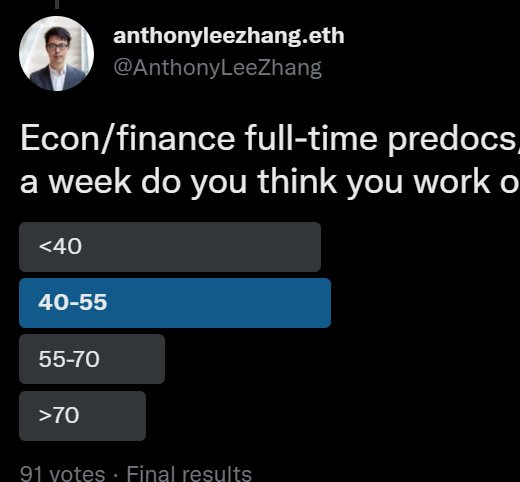Best of #econtwitter - Week of April 3, 2022 [1/3]
Apr 02, 2022
Welcome readers old and new to this week’s edition of Best of Econtwitter. Thanks to those sharing suggestions, over email or on Twitter @just_economics.
This is part one of three, with a special Saturday edition in order to smooth the large number of very good papers this week. Part two is here; part three is here.
Paper summary threads

Simon Jäger@simon_jaeger
Striking new paper @DrDaronAcemoglu, Alex He, and Daniel le Maire: Eclipse of Rent-Sharing: The Effects of Managers' Business Education on Wages and the Labor Share in 🇺🇸 + 🇩🇰. Managers with MBA ➡️ wages ⬇️ + labor share ⬇️nber.org/system/files/w…

6:26 PM · Mar 28, 2022
428 Reposts · 1.49K Likes

Simon Jäger@simon_jaeger
They draw on 🇺🇸 and 🇩🇰 admin data and show event studies of managers with MBA / business degree entering firms. Wages and labor share ⬇️, no noticeable productivity effects. 🇩🇰 event studies below.

6:26 PM · Mar 28, 2022
12 Reposts · 98 Likes

John Horton 🇺🇦@johnjhorton
@ryanmcdevitt @BetseyStevenson Maybe I’m misreading it, but it looks like positive point estimate on output of about the same magnitude (albeit considerably less precise). Even if identification is solid, I wouldn’t characterize this no effect on output - just not precise enough to say much

10:36 PM · Mar 28, 2022
23 Likes
^Substack cutting of the image again here

Barbara Biasi@BarbaraBiasi
🚨With @ProfSongMa, we recently released an updated version of our paper “The Education-Innovation Gap” as a NBER wp/CEPR dp. Here’s a short thread if you’re curious about what we do & find! 📜1/10

12:57 PM · Mar 31, 2022
91 Reposts · 308 Likes

Barbara Biasi@BarbaraBiasi
We decided to try to measure the extent to which courses are “at the frontier,” i.e., they cover recently disclosed knowledge. Our conjecture was that this knowledge is key for labor market success, innovation, growth.4/10
12:57 PM · Mar 31, 2022
7 Likes

Barbara Biasi@BarbaraBiasi
We constructed this measure-the E-Igap-as ratio of text similarities bw each syllabus and papers published a)many yrs ago and b)in last few yrs, using the text of 20Mpapers in top journals across years. Pic below summarizes the approach we use to do this text analysis.5/10

12:57 PM · Mar 31, 2022
6 Likes

Zachary Bleemer@zbleemer
Our main finding is simple: access to the economics major (first stage) substantially increases students' wages in their mid-20s (reduced form).

3:37 PM · Mar 30, 2022
4 Reposts · 21 Likes

Prof Dynarski@dynarski
New working paper!
No-strings, 4-yr tuition GUARANTEE increases apps 28 pp & enroll 9 pp
…but requiring students go thru needs-analysis to confirm eligibility increases apps just 9 pp & enrollments ZERO
Paper: tinyurl.com/bpeu8fen
Appendix: tinyurl.com/5dd7376v


NBER @nberpubs
An up-front, unconditional offer of free college is more effective at increasing application and enrollment than one requiring verification of financial need, from @ecburland, @dynarski, @michelmorek, @steph_r_owen, and @Shwetha144 https://t.co/BuzdzC8cyg https://t.co/rFJTIVzraw
6:23 PM · Mar 29, 2022
71 Reposts · 189 Likes
Interesting discussions

anthonyleezhang.eth@AnthonyLeeZhang
Alright, the results are out! Work hours:
Untenured faculty > PhD students > predocs > tenured faculty





anthonyleezhang.eth @AnthonyLeeZhang
Econ/finance untenured faculty: how many hours a week do you think you work on average? Including teaching/dept duties + research
11:32 PM · Mar 28, 2022
1 Repost · 21 Likes
^friendly reminder that self-reported data are fake news, but

Jacobus Cilliers@JacobusCilliers
Most RCT papers I read these days use the post-double selection (PDS) method by Belloni et al (2014). The approach uses the Lasso method to select control variables (X) that are EITHER predictive of y OR predictive of treatment (T). But I think this is wrong. Thread below.
11:10 PM · Mar 29, 2022
53 Reposts · 252 Likes

Matt Clancy@mattsclancy
Part of a thread about how the British Journal of Sports Medicine games impact factor (IF) score. Apparently IF divides ALL cites to a journal by a count of QUALIFYING article types. You can game IF by publishing stuff that gets cites but doesn’t qualify.

James Heathers @jamesheathers
BJSM went from publishing a few editorials every now and then, like most journals, to publishing MORE CINOs THAN ORIGINAL RESEARCH ARTICLES in some years.
The rise of CINOs neatly parallels the journal becoming IF rank #1 in Sports Medicine. https://t.co/LteS3LIWwr
3:39 PM · Mar 30, 2022
2 Likes

Dr Lisa Nivison-Smith@LNivisonSmith
As a PhD student, my supervisor never answered my emails.
Then I became a PhD supervisor and realised why
A thread🧵 of my mistakes and how to avoid them
#phdchat #AcademicTwitter
8:34 PM · Mar 30, 2022
5.61K Reposts · 19.6K Likes

